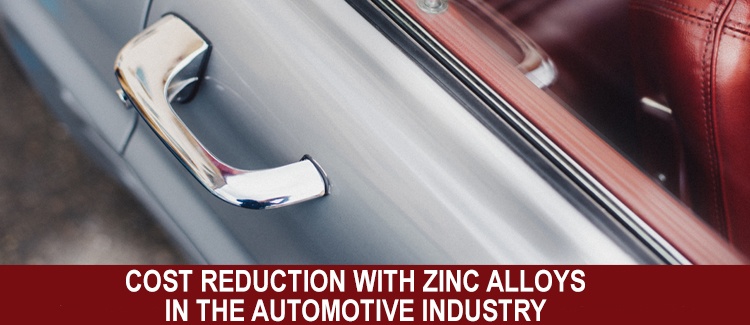As winner of numerous international awards, Bruschi Spa is known for its innovative approach in design and technology. We are glad to share our insights and experiences with the industry members.
Cost Reduction with Zinc Alloys in the Automotive Industry
Zinc is very versatile material: a combination of factors makes it a unique material from various perspectives, certainly from a cost point of view. According to that, the application of die cast zinc alloy components in the automotive industry can be an efficient solution to reduce production costs while maintaining the high levels of resistance, service life and hardness required by that sector.
Following are some of the advantages that make zinc a strategic material when striving for cost reduction for a company that is active in the automotive sector.
These are factors to bear in mind when considering zinc as an option:
- Production costs
- Surface treatments
- Machining precision
- Technical characteristics
- Energy savings
Zinc Alloys in the Automotive Industry: how to save on costs?
Production costs
To achieve a large cost reduction during production it is essential to highlight three aspects: molds, methods and the higher speed of production of HPDC (hot chamber) processes.
Molds for zinc die casting, other than aluminum casting dies which usually have a limited life span, must provide hundreds of thousands of castings and often cover the full production cycle without need for specific maintenance that would negatively influence the final cost for the client. The cost can therefore be better amortized resulting in a lower unit cost.
In terms of machining costs, the possibility to achieve high degrees of precision translates directly into a lower number of production rejects. Regarding tolerances to be achieved, one major advantage of zinc die casting is the possibility to fully eliminate the machining process, therefore necessitating fewer operations after ejection of the product from the die.
Another advantage of hot chamber die casting compared to cold chamber casting is the cycle time. The hot chamber process provides improved control over temperature at high production volumes, the process is faster during the ejection of the product whilst in the cold chamber method there is less control over the temperature of the molten metal and therefore a lower molten metal productivity.
Today’s automotive industry uses zinc for many of its components, certainly the more complex components where machining of various different raw materials would be difficult, other than costly.
Surface treatments
Speaking of surface finish, die cast zinc can be subjected to various options of surface treatments:
- Galvanic chroming
- Gilding and silver plating
- Zinc plating
- Painting
Just to mention a few finishing methods that are relatively simple to apply to zinc alloys in the automotive industry, as opposed to aluminum, for instance.
The treatments can give an aesthetic result if the component is visible, or strictly functional if not exposed to view. The material is predisposed for finishing operations and requires less preparatory work, simplifying decorative and functional treatments as needed.
Casting precision
From the point of view of tolerances to be achieved, the results obtained by zinc die casting are mostly unobtainable with other materials, other than through much higher production costs that would be beyond market acceptance. Thin Wall Castability (up to 0,65 mm thickness) of zinc alloys allows to realize smaller, lighter components at much lower cost.
Technical characteristics
Zinc alloys are particularly versatile materials and unique from the point of view of strength, sturdiness, rigidity, resistance to wear and atmospheric agents.
Furthermore, the competitive cost compared to other materials contributes to making zinc an efficient choice for clients in many industrial environments. Thanks to the material’s fluidity, very thin walls are obtainable. Therefore aluminum, even with its lower specific weight, loses its competitiveness to zinc.
Machining surface treatments, polishing and finishing also cost much less on zinc components compared to similar surface treatments on brass components, for instance.
From the technical aspect die cast zinc has many advantages, such as:
- High resistance to traction
- High limit of conventional elasticity
- Resistance to alternate bending
- Hardness, sturdiness and corrosion resistance
Zinc die cast products offer higher resistance to shock and wear compared to components in other metals or plastics. Zinc products have a hardness comparable to cast iron and brass and corrosion resistance can be vastly improved with galvanic finishing processes such as zinc coating, chroming or nickel plating.
Energy savings
Cost reduction can also be obtained by focusing on energy consumption. A low melting temperature is another positive characteristic: zinc alloys require less energy for smelting and for casting the product.
The melting point for zinc for instance is about 410/420°C, allowing for a considerable saving in energy and a mold life span up to 10 times longer compared to aluminum. The lower temperatures minimize thermic shock and drastically reduce defects due to wear of the mold.
Focusing on the extremely minimal environmental impact, zinc and zinc alloys do not spread pollution or venomous substances. Production scrap can be easily reutilized, remolten with low energy consumption and efficiently recycled.
To achieve these benefits we like to stress the importance of consulting with an experienced die caster, who needs to have great technical knowledge to be able to suggest the best choices to the client in every phase of the development of a new project: from collaborating with the client during co-design phase to defining surface treatments to be applied at a later stage.
For further information on zinc die casting, you are welcome to subscribe to our blog:


